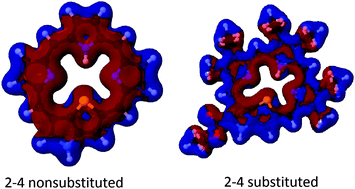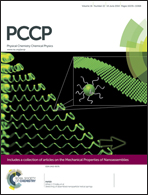The aromatic character of thienopyrrole-modified 20π-electron porphyrinoids†
Abstract
Magnetically induced current densities and current pathways have been calculated for six tautomers of substituted and nonsubstituted core-modified porphyrinoids with one of the pyrrole rings replaced by a thienopyrrole moiety. The calculations show that the aromatic properties of the porpyrinoid macrocycle are strongly influenced by the ethyl-formate substituent at the pyrrole ring of the thienopyrrole moiety, whereas the alkyl substituents at the β positions of the ordinary pyrrole rings have a much smaller effect on the ring-current strength. The ethyl-formate substitution decreases the strength of the paratropic ring current of the macrocycle rendering the energetically lowest tautomer nonaromatic. The substituted tautomers with both porphyrinoid hydrogens inside the macroring are antiaromatic according to the ring current criterion, whereas the three tautomers with one hydrogen at the outer nitrogen of the thienopyrrole moiety are nonaromatic. Current calculations on the nonsubstituted core-modified porphyrinoids show that they are all antiaromatic. The antiaromatic thienopyrrole-modified porphyrinoids are dominated by paratropic ring currents inside the macroring and a weaker diatropic current along the periphery of the macroring. The nonaromatic porphyrinoid tautomers sustain significant ring currents around the thienopyrrole moiety, whereas the other pyrrole rings are practically nonaromatic.


 Please wait while we load your content...
Please wait while we load your content...